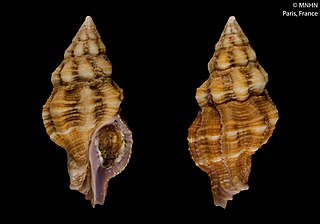| Oithona | |
|---|---|
| Scientific classification | |
| Domain: | Eukaryota |
| Kingdom: | Animalia |
| Phylum: | Arthropoda |
| Class: | Copepoda |
| Order: | Cyclopoida |
| Family: | Oithonidae |
| Genus: | Oithona Baird, 1843 |
Oithona is a planktonic crustacean genus found in marine, brackish, fresh water environments. [1] Oithona has been described as the most ubiquitous and abundant copepod in the world's oceans. [2] It was first described by Baird in 1843 using the species Oithona plumifera as taxon type. [3]
The following species are recognized: [1]
- Oithona aculeata Farran, 1913
- Oithona alvarezi Lindberg, 1955
- Oithona amazonica Burckhardt, 1913
- Oithona aruensis Früchtl, 1923
- Oithona atlantica Farran, 1908
- Oithona attenuata Farran, 1913
- Oithona australis Nishida, 1986
- Oithona bjornbergae Ferrari F.D. & Bowman, 1980
- Oithona bowmani Rocha C.E.F., 1986
- Oithona brevicornis Giesbrecht, 1891
- Oithona colcarva Bowman, 1975
- Oithona cruralis Nishida, Tanaka & Omori, 1977
- Oithona davisae Ferrari F.D. & Orsi, 1984
- Oithona decipiens Farran, 1913
- Oithona dissimilis Lindberg, 1940
- Oithona erythrops Brady, 1915
- Oithona fallax Farran, 1913
- Oithona farrani (Brady, 1915)
- Oithona flemingeri (Ferrari & Bowman, 1980)
- Oithona fonsecae Ferrari & Bowman, 1980
- Oithona fragilis Nishida, 1979
- Oithona frigida Giesbrecht, 1902
- Oithona gessneri Kiefer, 1954
- Oithona hamata Rosendorn, 1917
- Oithona hebes Giesbrecht, 1891
- Oithona horai Sewell, 1934
- Oithona linearis Giesbrecht, 1891
- Oithona longispina Nishida, Tanaka & Omori, 1977
- Oithona minuta Scott T., 1894
- Oithona minuta Krichagin, 1877
- Oithona nana Giesbrecht, 1893
- Oithona nishidai McKinnon, 2000
- Oithona oswaldocruzi Oliveira, 1945
- Oithona pacifica (Nishida, 1985)
- Oithona parvula (Farran, 1908)
- Oithona plumifera Baird, 1843
- Oithona pseudofrigida Rosendorn, 1917
- Oithona pseudovivida Shuvalov, 1980
- Oithona pulla (Farran, 1913)
- Oithona robertsoni McKinnon, 2000
- Oithona robusta Giesbrecht, 1891
- Oithona rostralis Nishida, Tanaka & Omori, 1977
- Oithona setigera (Dana, 1849)
- Oithona similis Claus, 1866
- Oithona simplex Farran, 1913
- Oithona splendens Baird, 1843
- Oithona tenuis Rosendorn, 1917
- Oithona vivida Farran, 1913
- Oithona wellershausi Ferrari F.D., 1982
- Oithona abbreviata (Dana, 1849) (taxon inquirendum, listed as "Unbestimmbare Species" by Giesbrecht, 1892)
- Oithona alia (Kiefer, 1935) accepted as Oithona rigida Giesbrecht, 1896 accepted as Dioithona rigida (Giesbrecht, 1896) (synonym according to Nishida, 1985)
- Oithona canhanhae Oliveira, 1945 accepted as Oithona hebes Giesbrecht, 1891 (placed in synonymy by da Rocha, 1986)
- Oithona challengeri Brady, 1883 accepted as Oithona setigera (Dana, 1849) (listed as synonym by Nishida, 1985)
- Oithona helgolandica (Claus, 1863) accepted as Oithona similis Claus, 1866
- Oithona neotropica Herbst, 1967 accepted as Oithona oswaldocruzi Oliveira, 1945 (placed in synonymy by da Rocha, 1986)
- Oithona oculata Farran, 1913 accepted as Dioithona oculata (Farran, 1913) (synonym )
- Oithona oligohalina Fonseca & Björnberg T.K.S., 1976 accepted as Oithona oswaldocruzi Oliveira, 1945 (placed in synonymy by da Rocha, 1986)
- Oithona oraemaris Oliveira, 1946 accepted as Oithona hebes Giesbrecht, 1891 (placed in synonymy by da Rocha, 1986)
- Oithona ovalis Herbst, 1955 accepted as Oithona hebes Giesbrecht, 1891 (placed in synonymy by da Rocha, 1986)
- Oithona ovata Lindberg, 1950 accepted as Oithona attenuata Farran, 1913 (synonymised by Nishida, 1985)
- Oithona pelagica Farran, 1908 accepted as Oithona setigera (Dana, 1849) (listed as synonym by Nishida, 1985)
- Oithona plumosa Lindberg, 1947 accepted as Oithona nana Giesbrecht, 1893 (synonymised by Nishida, 1985)
- Oithona pygmaea Boeck, 1865 accepted as Oithona similis Claus, 1866 (listed as probable synonym by Giesbrecht, 1892)
- Oithona rigida Giesbrecht, 1896 accepted as Dioithona rigida (Giesbrecht, 1896)
- Oithona sapucaiae Oliveira, 1945 accepted as Oithona hebes Giesbrecht, 1891 (placed in synonymy by da Rocha, 1986)
- Oithona scriba (Dana, 1849) accepted as Oithona plumifera Baird, 1843 (listed as synonym by Giesbrecht, 1892)
- Oithona sinensis Burckhardt, 1912 accepted as Limnoithona sinensis (Burckhardt, 1913)
- Oithona spinifrons Boeck, 1865 accepted as Oithona similis Claus, 1866
- Oithona spinirostris Claus, 1863 accepted as Oithona setigera (Dana, 1849) (listed as synonym by Nishida, 1985)
- Oithona spinulosa Lindberg, 1950 accepted as Oithona brevicornis Giesbrecht, 1891 (synonym according to Nishida & Ferrari, 1983)
- Oithona tropica Wolfenden, 1906 accepted as Oithona setigera (Dana, 1849) (listed as synonym by Nishida, 1985)






